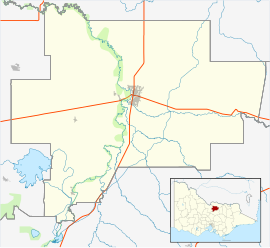Tatura, Victoria
|
Tatura Victoria |
|||||||||
|---|---|---|---|---|---|---|---|---|---|

Main street
|
|||||||||
| Coordinates | 36°26′0″S 145°14′0″E / 36.43333°S 145.23333°ECoordinates: 36°26′0″S 145°14′0″E / 36.43333°S 145.23333°E | ||||||||
| Population | 3,533 (2006 census) | ||||||||
| Postcode(s) | 3616 | ||||||||
| Elevation | 114 m (374 ft) | ||||||||
| Location |
|
||||||||
| LGA(s) | City of Greater Shepparton | ||||||||
| State electorate(s) | Shepparton | ||||||||
| Federal Division(s) | Murray | ||||||||
|
|||||||||
Tatura is a town in the Goulburn Valley region of Victoria, Australia. The town is in the City of Greater Shepparton local government area, 167 kilometres (104 mi) north of the state capital, Melbourne and 18 kilometres (11 mi) west of the regional centre of Shepparton. At the 2011 census, Tatura had a population of 4,448.
With a large corporate and manufacturing presence within the town, Tatura is a major employer within the Goulburn Valley. Organisations include Tatura Milk Industries, Goulburn-Murray Water's corporate headquarters, Sinclair Knight Merz, Department of Environment and Primary Industries (Victoria), as well as major regional processing plants for multinational corporations such as Unilever and Snow Brand Milk Products.
Attractions include the Cussen Park wetlands and the Wartime Camps and Irrigation Museum.
The name of the town is an Aboriginal word meaning "small lagoon."
The Post Office opened on 1 February 1875.
Several internment camps were set up around Tatura, Rushworth and Murchison (Dhurringile) during World War II. Four of these were for civilians, and 3 were for prisoners of war. There were 10,000 to 13,000 people in the camps at different times from 1940 to 1947.
Before the war, Britain was home to around 73,000 Germans, who had left Germany due to the rising tensions and the rise of the Nazi regime in the country. Many of these were also young male Germans who had been in schools in Britain before the outbreak of WWII. It was believed that many of these refugees were spies, and were shipped out of the country, predominantly to Australia on the HMT Dunera and Canada.
...
Wikipedia

